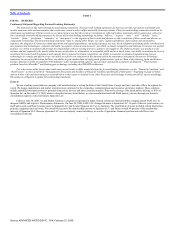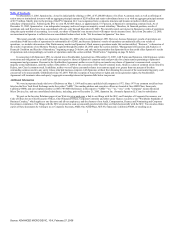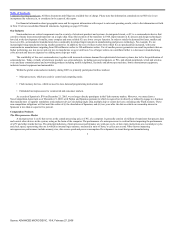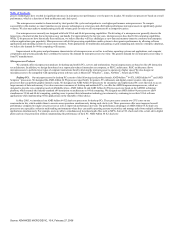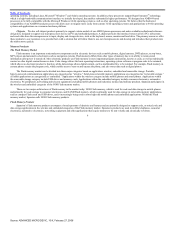AMD 2005 Annual Report Download - page 15
Download and view the complete annual report
Please find page 15 of the 2005 AMD annual report below. You can navigate through the pages in the report by either clicking on the pages listed below, or by using the keyword search tool below to find specific information within the annual report.
Table of Contents
microprocessors include numerous foreign and domestic manufacturers of servers and workstations, desktop and notebook PCs and PC motherboards. Generally,
OEMs do not have a right to return our products other than pursuant to the standard limited warranty. However, from time to time we may agree to repurchase a
portion of these products pursuant to negotiated terms.
In 2005, Hewlett-Packard Company accounted for approximately 12 percent of our consolidated net sales. Sales to Hewlett-Packard consisted primarily of
products from our Computation Products segment.
Third-Party Distributors
Our authorized distributors resell to sub-distributors and mid-sized and smaller OEMs and ODMs. Typically, distributors handle a wide variety of
products, including those that compete with our products. Distributors typically maintain an inventory of our products. In most instances, our agreements with
distributors protect their inventory of our products against price reductions and provide return rights with respect to any product that we have removed from our
price book or that is not more than twelve months older than the manufacturing code date. In addition, some agreements with our distributors may contain
standard stock rotation provisions permitting limited levels of product returns.
In 2005, Fujitsu accounted for approximately 15 percent of our consolidated net sales. Fujitsu primarily distributed Spansion Flash memory products.
Fujitsu is also an OEM customer with respect to products from our Computation Products segment.
Competition
The IC industry is intensely competitive. Products compete on performance, quality, reliability, price, adherence to industry standards, software and
hardware compatibility, brand recognition and availability. Technological advances in the industry result in frequent product introductions, regular price
reductions, short product life cycles and increased product capabilities that may result in significant performance improvements. Our ability to compete depends
on our ability to develop, introduce and sell new products or enhanced versions of existing products on a timely basis and at competitive prices, while reducing
our manufacturing costs.
Competition in the Microprocessor Market
Intel Corporation has dominated the market for microprocessors used in desktop and mobile PCs for many years. Intel is also a dominant competitor in the
server category of the microprocessor market. Intel’s significant financial resources enable it to market its products aggressively, to target our customers and our
channel partners with special incentives and to discipline customers who do business with us. These aggressive activities can result in lower unit sales and
average selling prices for our products, and adversely affect our margins and profitability. As long as Intel remains in this dominant position, we may be
materially adversely affected by Intel’s:
• Business practices, including pricing and allocation strategies and actions, such as aggressive pricing for microprocessors to increase market share;
• product mix and introduction schedules;
• product bundling, marketing and merchandising strategies;
• exclusivity payments to its current and potential customers;
• control over industry standards, PC manufacturers and other PC industry participants, including motherboard, memory, chipset and basic input/output
system, or BIOS, suppliers; and
• marketing and advertising expenditures in support of positioning the Intel brand over the brand of its OEM customers.
10
Source: ADVANCED MICRO DEVIC, 10-K, February 27, 2006



